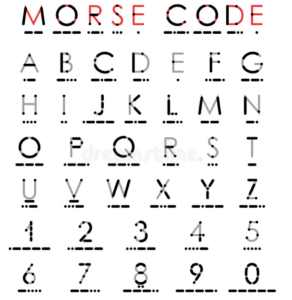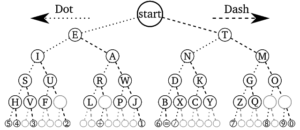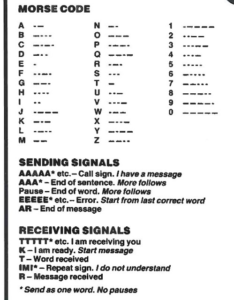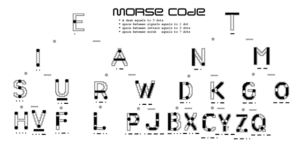I touched on the topic of Morse Code in the last post. I learnt AMA in under a day and Cykey coding in less than an hour. Could I memorize Morse? Here is how I approached the task.
Firstly, learn the letters as sounds. Use your phonetic alphabet and say the Morse after the letter. “Whiskey: dot, dash, dash” or “Quebec: dah, dah, dit, dah”.
Most of you will already know one bit of Morse. SOS is three dots, three dashes and three dots.
Learn the vowels first. Alpha is a simple dot-dash. Echo is the most used letter in English so is a single dot. India is two dots, like a pair of eyes. Oscar you already know from SOS. It is three dashes. Uniform is two dots and a dash.
Each of these vowels have a Morse character that is either their reverse or their inverse.
Alpha written backward is November, dash-dot. A and N form the word “An”. You cannot write Echo backwards but you can swap the dot for a dash. A single dash is Tango. E and T go together as in “ET phone home”. The inverse of India is Mike, two dashes. I and M form the abreviations “I’m” or “’im”. The inverse of Oscar is three dots, which is Sierra which you already know from SOS. Uniform backwards gives us Delta dash-dot-dot. D and U form “du”, a phonetic rendering of “do”. Or you could think of depleted uranium.
To the above we will slip in another letter you may already know. “V for Victory”, three dots and a dash you may have seen in old war films. The reverse of this is the Morse code for Bravo. B and V sound similar.
You have just learnt twelve letters in Morse code! That is nearly half the alphabet and includes some of the most commonly used letters. You can create many messages with just these.
Next, learn some simple words that use other characters. I learnt my name which gave me the codes for Papa, Hotel and Lima. The code for Lima reversed gives me that for Foxtrot. I associate this pairing by thinking Lima sounds like an animal and Foxtrot that it sounds like something to do with animals.
There are various ways to learn the other characters. Charlie is memorable because it seems odd it is so long. Dash-dot-dash-dot. Quebec, dash-dash-dot-dash also sticks in my mind. The reverse of Quebec is the code for Yankee. Associate this pairing by thinking both “Q” and “Why” can be questions.
The chart below is a visual representation of Morse code. You will see a number of different versions of this. I like this one since it reproduces the codes in a linear fashion beneath each character, avoiding misreading the graphic. This chart will help you remember some characters. Kilo is dash-dot-dash. “K” and “R” look similar and Romeo is the inverse of Kilo, dot-dash-dot.

Another chart, sometimes called a Morse Tree or dichotonic key. You will encounter different versions of these and some put “dash/ dah” on the other side, so look carefully. This key is mainly of use in translating from Morse. It helps me remember that Juliet is one dash more than Whiskey. The reverse of Whiskey is Golf. Golf and Whiskey are associated, or you can think of G and W paired as in “Gross Weight” or “Games Workshop”.

Some letters I remember by breaking them up into smaller letters. X-ray is dash-dot-dot-dash so I remember it as “NA”. Zulu is dash-dash-dot-dot so “MI”.
Memorizing the Morse code is not the same as being proficient or fluent in it, of course. An emergency situation is not a time for tests of memory if you can help it. Therefore I suggest you include backups.
I have a small wallet that holds credit cards, membership cards and the like. For years it has carried a laminated card I made with Morse code on. Many of you will recognize the book I photocopied the original from (Note misprint of numbers! All numbers have five elements). It is folded just above “Sending Signals” so that the alphabet is on one side of the card and the signals on the other.

For larger kits I suggest you consider a suitably sized rendition of the chart below. I have modified this so that the linear form of the codes is below each character.
